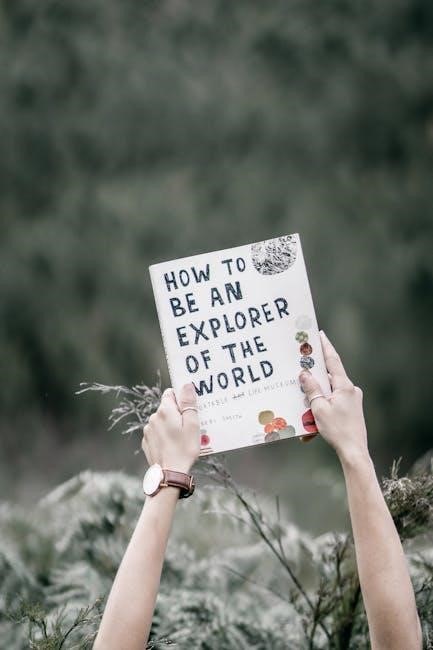Field guide books are essential tools for identifying and understanding natural elements like plants, animals, and minerals. They serve as valuable resources for students, researchers, and enthusiasts, blending detailed descriptions with visual aids to enhance learning and outdoor exploration.
Definition and Purpose of Field Guide Books
Field guide books are portable resources designed to help identify and understand natural elements like plants, animals, and minerals. They provide detailed descriptions, visual aids, and classifications to aid in recognizing species and their characteristics. These guides are essential for education, research, and outdoor activities, making complex information accessible to enthusiasts and professionals alike.
Historical Background of Field Guides
Field guides have a long history, dating back to early naturalist studies. They evolved from detailed scientific texts to more accessible formats, incorporating visuals like photographs and illustrations. Classic examples include the Stokes and Sibley guides, which set standards for modern field guides, blending accuracy with portability to aid enthusiasts in real-world applications.

Types of Field Guide Books
Field guide books cater to various interests, including flora, fauna, minerals, and specialized regional or species-focused guides, offering tailored information for diverse natural history exploration needs.
Flora and Fauna Guides
Flora and fauna guides specialize in identifying plants, animals, and fungi, often featuring detailed descriptions and visuals. They aid in distinguishing species, habitats, and behaviors, making them indispensable for nature enthusiasts, educators, and conservationists. These guides typically include high-quality photographs or illustrations, enabling users to recognize field marks and understand ecological roles effectively in various environments.
Minerals and Geology Guides
Minerals and geology guides provide detailed information on rocks, minerals, and geological formations, often including photographs and diagrams. They help users identify specimens based on color, texture, and other characteristics. These guides are invaluable for geologists, students, and hobbyists, offering insights into geological processes and the natural history of minerals, making them essential for fieldwork and study.
Specialized Guides for Specific Regions or Species
Specialized field guides focus on particular regions or species, offering in-depth information tailored to specific ecosystems or taxonomic groups. These guides often feature localized data, making them indispensable for researchers and enthusiasts. They enhance identification accuracy and provide a detailed understanding of unique biodiversity, fostering targeted exploration and conservation efforts in distinct areas or for specific organisms.
Key Features of a Field Guide Book
Field guide books are designed for clarity and portability, featuring detailed descriptions, high-quality visuals, and organized information to aid quick identification and understanding in outdoor settings.
Detailed Descriptions and Classifications
Field guide books provide in-depth descriptions of species, habitats, and characteristics, often supported by scientific classifications. This structured information helps users accurately identify and categorize natural elements effectively, making it essential for precise understanding and research in the field.
Visual Elements: Photographs, Illustrations, and Diagrams
Field guide books often feature high-quality photographs, detailed illustrations, and clear diagrams to aid in identification. These visuals highlight key characteristics, such as color patterns, shapes, and structures, making it easier for users to recognize species or objects in their natural settings. Enhanced images and diagrams ensure clarity and accuracy for quick and effective identification.
Portability and Practicality for Outdoor Use
Field guide books are designed with portability and practicality in mind. Compact sizes and durable materials ensure they withstand outdoor conditions. User-friendly layouts and clear organization help users quickly identify species. Features like weather-resistant pages, sturdy bindings, and easy-to-carry formats enhance reliability, making them indispensable companions for fieldwork and nature exploration.
How to Use a Field Guide Effectively
Mastering a field guide involves understanding its structure and practicing identification skills. Familiarize yourself with the guide’s layout before heading outdoors to enhance your ability to identify species efficiently and accurately, ensuring a more rewarding experience in nature.
Preparation: Understanding the Guide’s Layout and Structure
Preparation involves thoroughly studying the field guide’s organization to maximize its effectiveness. Familiarize yourself with sections like taxonomy, visual indexes, and habitat descriptions. Understanding how information is categorized, such as by species or region, ensures quick access during field observations. This foundational knowledge enhances efficiency and accuracy when identifying specimens or phenomena in real-time settings.
Practice: Enhancing Identification Skills Over Time
Regular practice with a field guide is essential for improving identification skills. Start by observing familiar species to build confidence, then gradually tackle more complex ones. Consistent use helps develop a keen eye for detail, reducing reliance on the guide over time. Hands-on experience and real-world application are key to mastering identification techniques effectively.
The Importance of Field Guide Books
Field guide books are essential for connecting people with nature, fostering education, and supporting conservation efforts. They serve as vital resources for learning and environmental stewardship.
Role in Conservation and Environmental Education
Field guide books play a crucial role in conservation by raising awareness about endangered species and ecosystems. They educate readers about the importance of biodiversity, promoting environmental stewardship. These books empower individuals to contribute to conservation efforts, fostering a deeper connection with nature and inspiring action to protect the planet for future generations.
Value for Researchers, Students, and Enthusiasts
Field guide books are invaluable for researchers, offering detailed classifications and accurate information. Students benefit from their structured content, enhancing learning. Enthusiasts appreciate their portability and visual aids, making species identification accessible. These books bridge academic and practical knowledge, fostering a deeper appreciation of nature and supporting lifelong exploration and discovery for diverse audiences.

Creating a Field Guide Book
Creating a field guide involves extensive research, collaboration with experts, and careful design to ensure accuracy and usability. It demands attention to detail and practical insights to aid identification in the field effectively while maintaining accessibility for diverse audiences.
Research and Collaboration with Experts
Researching a field guide requires thorough data collection and verification to ensure accuracy. Collaborating with experts enhances credibility, as their insights provide authoritative information. This teamwork ensures the guide is both comprehensive and reliable, making it an indispensable resource for users seeking detailed knowledge on specific subjects or regions.
Design Considerations for Usability
A well-designed field guide prioritizes user-friendly layouts, clear typography, and vibrant visuals. Portability, durability, and intuitive organization are key, ensuring the guide is accessible outdoors. High-quality images and concise descriptions aid quick identification, while robust indexing and cross-referencing systems enhance usability, making the guide indispensable for fieldwork and education.

Case Studies: Popular and Influential Field Guides
Explore influential field guides like The Stokes Field Guide Series and The Sibley Guide to Birds, which have revolutionized nature education and conservation efforts globally.
The Stokes Field Guide Series
The Stokes Field Guide Series, known for its meticulous detail, offers comprehensive insights into bird identification. With vibrant photographs and clear descriptions, it aids enthusiasts in recognizing species based on plumage and behavior. The series has become a trusted companion for birders, emphasizing authenticity and accessibility, making it a cornerstone in nature study and conservation efforts.
The Sibley Guide to Birds
The Sibley Guide to Birds, authored by David Allen Sibley, is renowned for its detailed, life-like illustrations and comprehensive coverage of bird species. It includes various plumages, seasonal changes, and range maps, making it a leading resource for bird identification. Its meticulous artwork and thorough descriptions have solidified its reputation as an indispensable tool for bird enthusiasts and researchers alike.

Modern vs. Traditional Field Guides
Modern field guides integrate technology like apps and augmented reality, enhancing accessibility and interactivity. Traditional guides remain popular for their portability and tangible experience, offering a classic learning approach.
Digital Field Guides and Apps
Digital field guides and apps offer interactive features like image recognition, real-time updates, and location-based data. They enhance identification accuracy and accessibility, appealing to tech-savvy users while maintaining the core educational purpose of traditional guides.
Comparing Print and Digital Formats
Print field guides offer tactile experiences and durability, ideal for outdoor use without tech reliance. Digital formats provide convenience, searchability, and frequent updates, making them perfect for quick access. Both formats cater to different user preferences, ensuring comprehensive coverage for nature enthusiasts and researchers alike.
Future Trends in Field Guide Books
Future trends in field guide books include integration of augmented reality for immersive experiences and eco-friendly publishing practices, enhancing learning while promoting sustainability and aligning with modern conservation goals.
Integration of Technology and Augmented Reality
Augmented reality (AR) is revolutionizing field guide books by enhancing identification processes. AR-enabled guides bring static images to life, allowing users to view species in 3D or observe behaviors in real-time. This technology, combined with digital platforms, provides interactive learning experiences, making field guides more accessible and engaging for modern audiences while fostering deeper connections with nature and conservation efforts.
Sustainability and Eco-Friendly Publishing Practices
Modern field guide books increasingly adopt eco-friendly practices, such as using recycled paper and plant-based inks. Publishers prioritize sustainability to minimize environmental impact while maintaining high-quality content. Digital versions further reduce material use, aligning with contemporary demands for greener solutions and reflecting a growing awareness of environmental responsibility in educational publishing.

Challenges in Creating and Using Field Guides
Creating field guides requires balancing accuracy with accessibility, ensuring updates reflect new discoveries, and addressing portability for practical outdoor use while maintaining comprehensive detail.
Accuracy and Updating Information
Ensuring accuracy and updating field guides is challenging, as new discoveries and taxonomy changes require frequent revisions. Collaboration with experts is crucial to maintain reliability, while balancing detail with accessibility for users. Portability and practicality must also be considered to ensure guides remain effective tools for outdoor use.
Balancing Detail with Accessibility
Field guides must balance comprehensive information with user-friendly design. Too much detail can overwhelm, while too little may be insufficient for accurate identification. Clear layouts, concise descriptions, and high-quality visuals help make complex information accessible to both experts and novices, ensuring the guide is practical for diverse audiences and effective in various outdoor settings.

Selecting the Right Field Guide
Selecting the right field guide involves considering factors like region, subject matter, and target audience to ensure relevance and usability for effective identification and learning in the field.
Factors to Consider: Region, Subject, and Audience
When choosing a field guide, consider the region to ensure relevance to your location. Select guides focused on your subject of interest, such as birds or plants, and choose guides tailored to your audience, whether you’re a student, researcher, or casual enthusiast, to maximize usability and effectiveness in the field.
Reviews and Recommendations for Choosing the Best Guide
Consult reviews from experts and users to evaluate a field guide’s accuracy and usability. Recommendations from educational institutions or conservation organizations can highlight trusted titles. Online forums and communities often provide insights, helping you select a guide that meets your specific needs and enhances your field experiences effectively.

The Educational Role of Field Guides
Field guides are vital educational tools, fostering curiosity and hands-on learning in schools and outdoor programs. They empower students to explore and understand nature, preparing future stewards of the environment.
Enhancing Learning in Schools and Outdoor Programs
Field guides enrich educational experiences by providing interactive, hands-on learning tools. They help students identify species, understand ecosystems, and develop critical thinking skills. In outdoor programs, they foster engagement with nature, promoting environmental awareness and stewardship.
Encouraging Citizen Science and Community Engagement
Field guides empower individuals to contribute to scientific research and conservation efforts. By enabling amateur naturalists to identify species accurately, they foster community-driven projects and environmental monitoring. This collective participation strengthens local stewardship and promotes a deeper connection to nature.

Field Guides and Conservation Efforts
Field guides play a vital role in conservation by raising awareness about endangered species and educating individuals on wildlife protection. They empower people to contribute to environmental preservation through informed action and advocacy.
Raising Awareness About Endangered Species
Field guides highlight the critical status of endangered species, offering detailed descriptions and visual aids to educate readers. By emphasizing the importance of conservation, they inspire action and promote awareness, helping to protect vulnerable species and their habitats for future generations.
Empowering Individuals to Contribute to Environmental Protection
Field guide books empower individuals by providing knowledge and practical tools for environmental action. They encourage conservation practices, habitat preservation, and eco-friendly behaviors. By fostering a deeper connection with nature, these guides inspire people to take an active role in protecting ecosystems and contributing to sustainability efforts.
Key Takeaways
Field guide books are invaluable for conservation, education, and outdoor exploration. They have evolved from traditional print to digital formats, offering enhanced accessibility and engagement for nature enthusiasts and researchers alike.
Field guides are indispensable tools for conservation and education, providing detailed insights into natural elements. From traditional print formats to modern digital versions with augmented reality, they have evolved to enhance accessibility and engagement, empowering users to explore and understand the natural world more effectively while supporting environmental protection and scientific research.
Encouragement to Explore and Utilize Field Guides
Exploring field guides opens doors to discovering nature’s wonders. Whether through traditional books or innovative digital apps, these resources empower everyone to engage with the environment. By using field guides, individuals can deepen their knowledge, foster a sense of curiosity, and contribute to conservation efforts, making them invaluable tools for lifelong learning and outdoor adventures.
